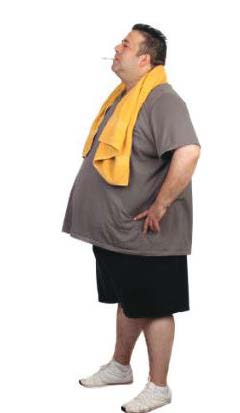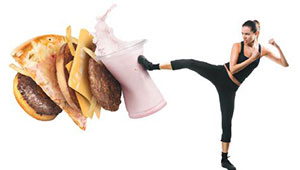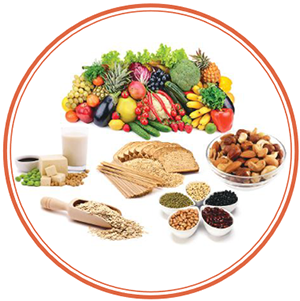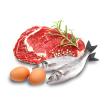Diet & Lipid Disorders

Cardiovascular disease represents a big health burden in the middle east and Africa. This is mainly due to many contributing factors like:

- Sedentary life style and office jobs, alongside with the hot weather that is present most of the year.
- Lack of exercise.
- The diet that is mostly high in fat and sugar.
- High prevalence of diabetes mellitus
- Obesity
- Easy availability of restaurant food and takeaways.
- High cholesterol levels in the blood as a result of all the factors mentioned above.
- Smoking including shisha.
Studies showed that the average age of a person having major heart attack is 51 years old in the middle east. This is 12 years younger than patients living in the western countries(1).
Where do we get lipids from?
Our body gets lipids from 2 sources:
- Food absorbed by our intestine and stored in the body and liver.
- Lipids produced by our liver.
What are the different types of lipids in our blood?
It is a very complicated classification but what you need to know are the following types.
- Cholesterol is a type of fat present in the body and cells. It needs to be within a certain limit. If cholesterol levels build up in the blood and in the arteries, the risk of a heart attack or a stroke increases
- Triglyceride is another type of fat found in your blood. It is usually associated with central obesity (big tummy), Diabetes mellitus and thyroid gland disorders.
- LDL are called “ bad lipids”. High levels of LDL increase your risk of heart attack and stroke
- HDL are “good lipids”. This usually provides heart protection if it is within the desirable limits.
How do I get my lipids checked?
Your doctor can order this blood test for you. Sometimes high lipids are discovered during regular health check ups. You will need to be fasting for the blood test as some of the results may vary if you had some food.
You will need to see your doctor after the blood test to discuss the results.
What if my lipid levels are high?

Your doctor may prescribe medications to lower this level depending on your medical condition, if you have other disease like cardiovascular disease and/or Diabetes mellitus.
If you are healthy, but your blood lipid levels are high, then you will be advised to try to modify your life style. For example, stop smoking, lose weight, exercise regularly and modify your diet.
What are the unhealthy fats in our food?
- Cholesterol: Cholesterol is found only in animal products such as egg yolks, shrimps, meats, liver and other organ dairy.
- Saturated fat: Saturated fats are typically solid at room temperature. Saturated fats occur naturally in many food. The majority come mainly from animal sources, including meat and dairy products. Many baked and fried food contain high levels of saturated fats. Some plant-based oils, such as palm oil and coconut oil, also contain primarily saturated fats, but do not contain cholesterol.
- Trans-fat: Trans-fat is used in processed, fried, and baked food
A diet that is high in cholesterol, saturated fat and trans-fat can raise the level of cholesterol in your blood. High levels of LDL cholesterol (the bad cholesterol) in your blood increase your risk of heart disease and stroke.
What diet should I follow when my lipids are high?


- Choose healthy fats in your diet:
- Avocados
- Unsalted nuts (30-35 gm daily) - cashew, walnuts, almonds, pistachios, sunflower seeds
- Vegetable oils- olive, canola, corn, soybean, safflower, peanut, sesame oil
- Omega 3- Sardines, mackerel, salmon, herring, flaxseed oil, flaxseed seeds, walnuts, rocket leaves
- Cut down your fat intake: Follow a low saturated fat, low cholesterol diet.
- Avoid butter or margarine (except those advertised as low in trans fats or trans fat free), coconut oil, palm oil, lard and ghee (samneh).
- Increase omega 3 fatty acids in your diet. Consume salmon, herring, trout, tuna, and sardine twice per week. Consume shellfish in moderation.
- Eat more fiber: fiber is known to have good health benefits in many diseases, especially heart disease as it can lower the blood cholesterol level. Keep your diet rich in fresh fruits and vegetables, legumes (beans, lentils, etc.) whole grains, brown rice, oats, and whole-wheat cereals.
- Limit salt and caffeine.
- Have less than two alcohol drinks per day (avoid if overweight)
- Avoid soft drinks
- Exercise regularly: Get moving- being physically active will help you shape up and feel great. Thirty minutes of activity every other day helps you control your weight and lower your blood pressure.
- Keep your weight in a healthy range: Lose weight if you are overweight or obese. The key to good health is exercise and wise food choices.
- Quit smoking.
How to cut down fat?
- Avoid coconut oil and palm oil as they are high in saturated fat
- Remove visible fat from meat before cooking. Avoid: fatty cuts of meats, organ meats (such as liver, brain, and kidney), sausage and bacon, luncheon meat and all processed meats.
- Remove the skin off the chicken before preparation.
- Avoid full fat dairy products, butter, lard. Use skimmed or partly skimmed dairy products like fat free labneh, low fat white cheese, and low fat sour cream instead.
- Limit eggs to 2-3 times per week. Egg white is not limited.
- Cook your food with small amounts of fat, and flavour with garlic, onions, celery, lemon juice etc.
- Boil, roast or grill your meat instead of frying it.
- Use a pan coating spray for oven baking instead of spreading the pan with oil.
- If frying is necessary: use minimal amount of oil, pour the fat from the pan and throw it away, drain fried food on paper towels before serving
- Cool the broth produced from boiling of meat or chicken. Skim off the top fatty layer.
- For takeaways try to read the label, avoid any food that has more than 20 mg of fat in each 100 mg.
- Reduce salt in your diet.
Avoid:
- High-fat frozen desserts such as ice cream
- Regular cakes
- All Arabic sweets
- Commercial cookies and pies
- Buttered pop corn
- Chocolate bars
- High-fat beverages such as milkshakes
Diet Summary table
| Food Groups | Choose | Avoid |
|---|---|---|
| Grains
|
|
|
| Food Groups | Choose | Avoid |
|---|---|---|
| Vegetables
|
All vegetables (steamed raw, boiled, or baked without added fat) | Fried vegetables |
| Fruits
|
All types of fruits | |
| Meats
|
|
|
| Food Groups | Choose | Avoid |
|---|---|---|
| Milk & dairy
|
|
|
| Fats and oils
|
|
|
| Desserts
|
|
|

References
- Coronary artery disease in Africa and the Middle East, Wael et al. Ther Clin Risk Manag. 2012; 8: 65–72. Published online 2012 Feb 16. PMCID: PMC3284217
- Heart UK, The cholestrol charity. Six super food that actively help lower cholestrol.
- Vannice G and Rasmussen H. Position of the academy of nutrition and dietetics: dietary fatty acids for healthy adults. Journal of the Academy Nutrition Dietetics. 2014 Jan;114(1):136-53. doi: 10.1016/j.jand.2013.11.001.










